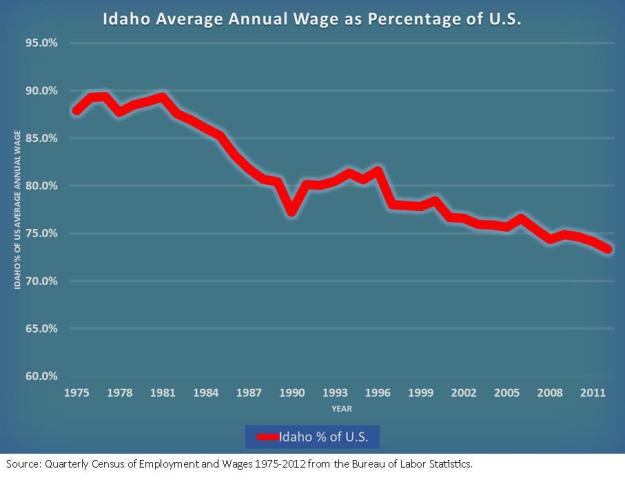As EORAC (The Economic Outlook and Revenue Assessment Joint legislative Committee) starts it’s meeting for this year, I am reminded of a comment by a fellow member a few years back. EORAC is tasked with recommending a revenue projection to JFAC so a budget can be set for the coming year. Idaho’s Constitution, like many states, mandates that government may spend no more each year than it takes in. Idaho tax revenue is of course mainly dependent on sales tax and income tax. Property taxes (also about a third of the Idaho tax burden) mainly go to local governments. Income and consumer activity is quite dependent on the economic climate, so the committee listens to many experts discuss their weather predictions for the coming year. When we heard from Idaho Department of Labor in 2014, House Speaker Scott Bedke seemed surprised by Idaho low wages. At that time Idaho had the highest percent of minimum wage earners (now we are 49th), and the lowest average wage in the country (still 50th). The Speaker asked that the numbers be repeated to the legislators for emphasis and suggested we consider our policy actions to address this. He’s right; our state leaders should understand this predicament.
But it’s not news. This has been a long time coming.
This paper provides a good analysis of each sector. Interestingly, when I have had this discussion with Republicans who will talk to me about this, they point to 1980’s as when environmental pressures hurt logging and mining. But those Idaho jobs actually pay above the national average and have for the last 30 years. Health care workers have driven this decline the most; their pay has lagged and the sector has grown.
So why hasn’t the market solved this for us? You’d think businesses would want to come to a place where the workers get paid less, then as demand for workers increases, the pay would also. Idaho has had some ups and downs, but overall the 30 year trend is swirling the drain. State Impact Idaho tried to get people’s attention about this issue 4 years ago. They did a great job, but it sure didn’t fire up any voter outrage.
The consequences we see of this trend are that bright young folks are leaving the state for better employment opportunities elsewhere and older, gray haired, fixed income folks are coming in to take advantage of the low pay. Such a demographic change will have a long influence on the economy, and the politics.
A further consequence, since we started talking about revenue, is that since people make less, the state collects less revenue to pay for schools and other services. If incomes rose, we could actually lower the tax rate and still get enough revenue to do the work the state should be doing.
So what should policy makers do? First, I would wonder if any see this as a problem. My sense was that Speaker Bedke did, but I sure didn’t hear others join him. When I can get Republicans to talk about this they usually deflect the low wages to a comparably low cost of living in Idaho. But they are wrong again. Idaho’s cost of living is about 30th nationally, while wages are 50th.
I have heard one lawmaker dismiss low wages as a problem. He also considered the goal of economic growth, especially for rural areas a mistake. “People like things the way they are; otherwise they wouldn’t be livin’ here. Why try to change things?”
As I sit in the distant back seat and watch EORAC hear testimony about Idaho’s economic forecast, I wonder who’s speaking up for the workers in Idaho? Do they have a seat on this bus?
All comments read but not posted.

